#Drawing on canvas with markers is a strange activity
Explore tagged Tumblr posts
Text
Happy new year ヾ(❀╹◡╹)ノ゙❀~

#myart#protoss#My first art in 2025#protoss oc#starcraft#my oc#oc#senia#sho#mira#Sati#siya#Yais#alesta#agnes#viola#Okay#I have a bad memory for names.#But there are really a lot of them here#Drawing on canvas with markers is a strange activity#But I did it
13 notes
·
View notes
Note
I now love Siy, do tell more about them :)
Also HOW DID U DRAW THEM LIKE THE GAME!!
Aah, thank you for the ask (and the very kind reblog)!
I'm going to answer the drawing portion first, as I feel that will be more helpful to anyone who's curious! Siy information will be below the cut :]
The speedpaint is cropped so it can be seen better, but I've included what my full canvas looked like as well. The biggest thing for mimicking the art style was looking at the other sprites constantly. I would look at the sprites and find something close to what I was trying to draw, and then stare at that specific part while I worked. For example, Nate's hand, Everett's arm, and Jeremy's tie! Also, I blatantly copy-pasted the uniform pattern, because no way was I gonna try to recreate that 😭
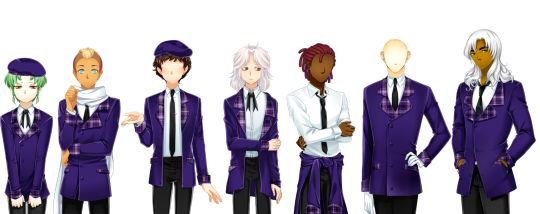
Now, for a small (well, not really small) Siy lore dump under the cut! Warning for a cliche and edgy, self-indulgent OC 💖
Also, Siy sounds a lot like Pran in this, but I assure you, Siy is not inspired by Pran! They are just the XOD version of a character I already had, who happened to also have white hair and a lack of interest in speaking, LOL
Siy, full name Siy Lencten, is a new student at Saint Sarah Belle, transferring during the same year as JB. After their best friend died, Siy went completely mute, believing there was no point in talking to anyone if she wasn't around. Their parents tried everything — therapy, extracurriculars, leave from school — but nothing seemed to get through to them.
That was when Siy's older cousin, who had previously gone to Saint Sarah Belle, mentioned sending Siy there. He told Siy's parents about the strange new friendship-making groups his friends who still went there were being forced into. Siy's parents thought it would be the perfect opportunity for Siy. Maybe some time away from home and some new friends would be just what they needed.
Their parents spoke with the school, and they were placed in the Jerk Squad. Siy was not interested in new friends or fun activities, so it was honestly a bit of a relief to be placed where they were. Lynn let them sit silently with their head down as much as they wanted. What a dream, well, at first.
Eventually Lynn asked them to stay after a meeting, and gave them one of those small school whiteboards for during meetings, asking that they at least answer when asked a question. Of course, the whiteboard thing didn't go over smoothly with the other Jerks, but they all got over it eventually.
And so, yeah! They start to open up more in the second year, but they never fully come out of their shell ^^;;
Have some Siy fun facts because I love them dearly:
- Their last name is the word "Lent" is believed to have come from, meaning their name can be interpreted as Siy Lent, or silent 😭 I'm so funny 💔
- Their best friend that died is named Annabelle Eden Lee, a reference to Edgar Allan Poe's final poem.
- The first people to hear them speak are Jeremy and Pran, because Siy feels like they're the only ones who wouldn't make a big deal about it in one way or another.
- Lynn gives them a portable whiteboard with a marker holder for their first birthday with the group 🥹
- They run cold, and generally wear around 3-4 layers on warm days, and up to 6 or 7 on cold ones.
- They have heterochromia (one green eye and one blue eye), but they wear hazel contacts because they don't like attention. They chose Hazel so that if they ever say the wrong color, people won't question it 😭
- They hate JB at first because she doesn't take the hint that they want to be left alone, but eventually she grows on them <3
- They were assigned male at birth, but their parents are very supportive, even if their dad still screws up their pronouns sometimes 💀
If you read this far, have some Siy and Jeremy sketches as a treat 🫳
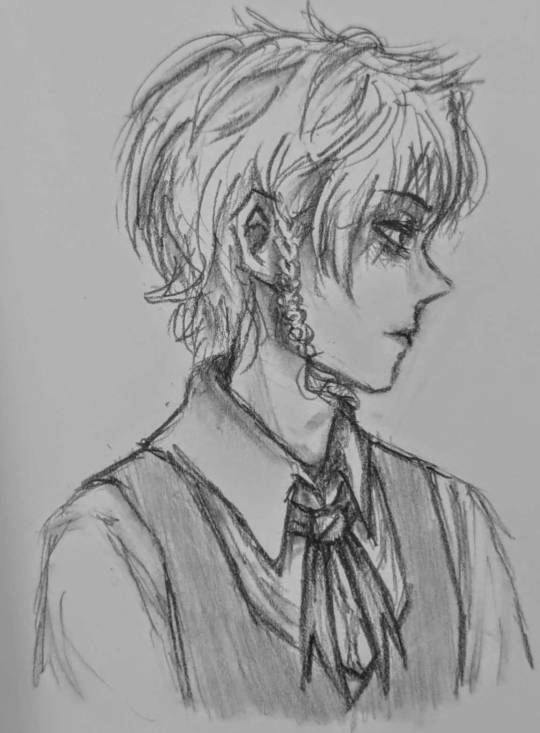
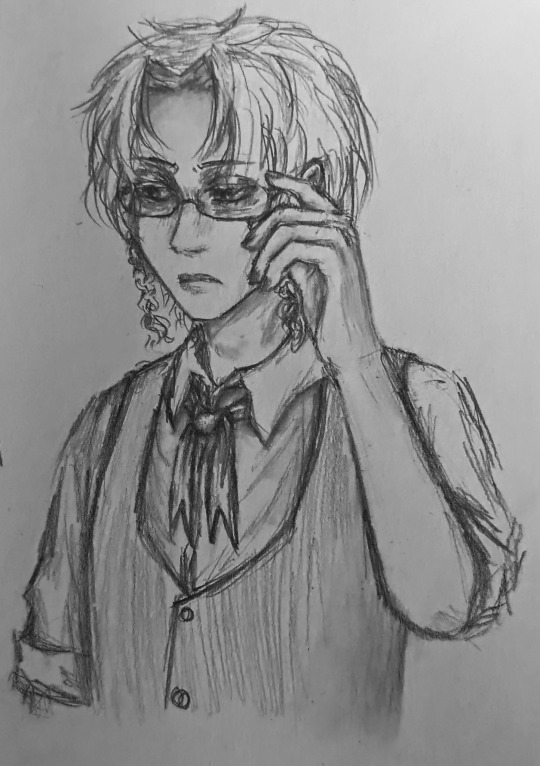
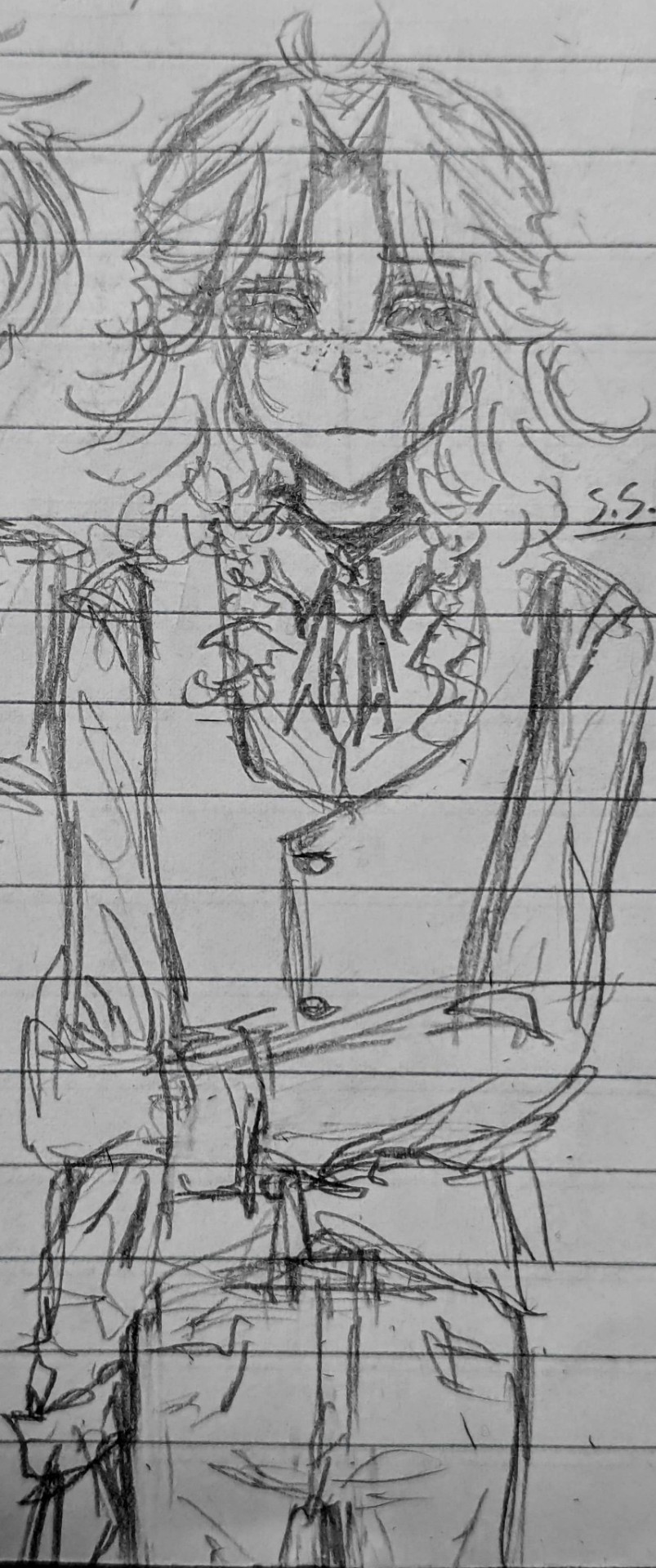
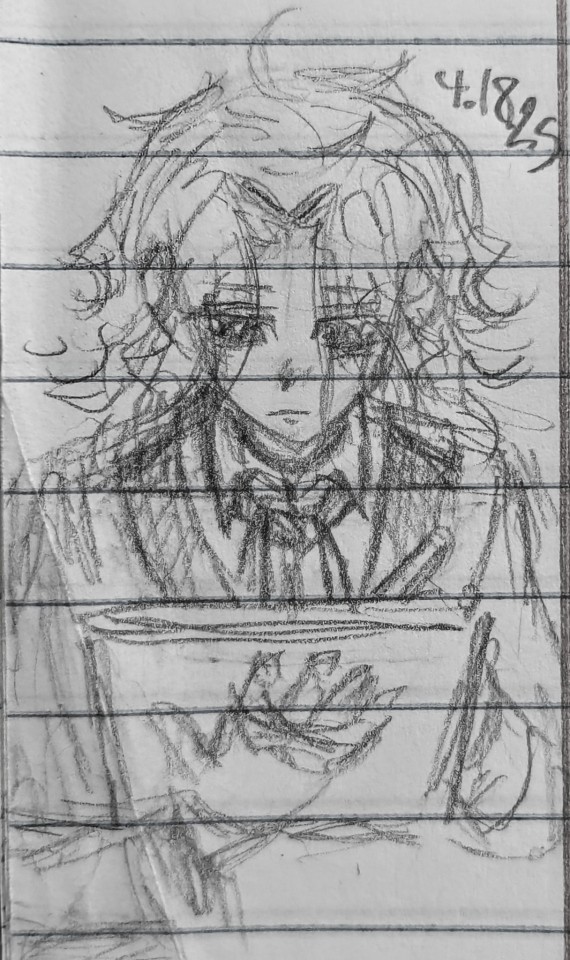


#xoxo droplets#xoxo droplets oc#xoxo droplets jeremy#xoxo droplets fanart#xod jeremy#xod oc#gb patch games#gb patch#solixfliar.png#solixfliar
16 notes
·
View notes
Text
‧₊˚✧ ཻུ۪۪ ᵕ̈ ART
chapter 1 — “drawings„
sakusa kiyoomi x reader | mlist
is having a soulmate necessary? — a bunch of connected stories.
Soulmate AU; if you write something on your skin it will appear on your soulmate skin too.
wc: 1,5k | no trigger warning.
Everyone has a soulmate, everyone deserves love, also if they don’t believe it. Sooner or later, in your sixteenth year of life, if you wrote something on your skin, it would show on your soulmate’s skin, same writing, same place.
Sakusa had never cared about soulmates, probably because a relationship wasn’t one of his priorities. He also thought no one could love him, mainly for his strange, cold and blunt personality, for his germaphobic attitude, and he thought girls liked to go out in crowded places with their boyfriends. He just didn’t care, and he hoped to have a soulmate who didn’t care either.
It happened all of a sudden, while he was writing on his notebook, he saw something appearing on his left wrist: “;”, a semicolon. At first, he thought his pen was bleeding a little ink, but when he tried to rub on it, nothing changed. It was like tattooed, and he couldn’t do anything. A couple of minutes after he realised he had a soulmate. Well, another problem added to his germophobia and mysophobia. Instead of panicking for the small amount of black colour on his wrist, he just pulled on his sleeve to cover it.
He wanted to keep it a secret, at least for now.
Some days have passed since the semicolon, and everytime it got erased, maybe from a shower or a bath, his soulmate was quick to draw it again. For him, if it was just that small symbol, it was okay. “Sakusa, what’s that flower on your arm?” Komori, during the whole practice his eyes were glued to his friend’s forearm, noticing that something was appearing out of the blue. “What?” he was focused on spiking the balls, that he didn’t saw the outline of a flower which started to mark his skin. “Guys! Our ace as a soulmate! And she’s also pretty talented!” the libero said to all his teammates, who got near Sakusa to admire the beautiful drawing on his arm. “Stop, I don’t like having you squished around me like this” he said, trying to move away from the small crowd composed of his teammates.
When Itachiyama’s ace got back to the locker room, he noticed that the drawing on his arm was a sunflower, and now there were also some leaves around it. The outline was perfect, without any kind of mistake or imprecision. But why? Why draw something so big and beautiful which can be easily erased with water and soap? Maybe, his soulmate did it just to annoy him, or because she didn’t care about him. He hoped it was the second.
Practice ended, and he was free to go back home, but something on his way caught his interest. A faint light coming from the art room. Minding other people’s businesses wasn’t his favourite activity, and he didn’t want to annoy who was inside. He stood near the door, and with surprise, a [h/c] hair coloured girl was standing near a canvas, and she was looking for more paint. Then, he looked at the unfinished drawing, representing a sunflower, very very similar to the one on his arm.
He was just watching her looking for some spare paint around the class. Carefully, without wasting a single drop, the girl put the colours on her palette, now looking for an appropriate brush to start her piece. The [h/c] student began painting with a yellow brush stroke, the firm hold of the brush was in contrast with the delicate move. He couldn’t see her face, but he bet it was plain, paying attention to all the small details, careful of what she was doing.
To almost everyone, that movement may seem normal, but there was something more. Her precision, her gentle brush stroke, her concentration. It was almost unnatural. She was in her personal world, a free, peaceful, imaginary space. When you do something you deeply love, it’s like this, reading, playing an instrument, playing your favourite sport... also if you don’t notice it.
While Sakusa was thinking if she really was his soulmate, he didn’t pay attention to the painting, where the petals of the sunflower were almost finished. Yellow, mixed with a bit of orange. Then, she moved on, and picked a dark brown bottle of paint. The girl started placing some dots in the center of the sunflower.
The artist felt eyes on her, but she didn’t care. Art is made to be seen and appreciated, is made to feeling part of it, is made to reveal your own feelings. Writing a story, composing a poem, singing a song, painting a drawing... are just a few of the ways art can express itself. It’s something magical, or at least, she would describe it like that.
“You know, drawing is a really good activity to reduce anxiety and sadness” she said without turning, knowing someone was leaning on the doorframe. Sakusa stayed still and didn’t answer back. “It also helps your concentration and creativity. Someone thought about how our psychic state reverses itself on the paper which we are drawing on. It sounds impossible, but it’s true.”
— 🌻 — some time after
Sakusa was staring to the ceiling of his room, laying on the bed. He was still thinking about the words he had heard before, also if he didn’t know that girl, the one in the art room, he couldn’t do anything besides being impressed. Her technique, her delicate touch, her thoughts.
Maybe it was just a coincidence, but the drawings, the sunflowers... was her his soulmate? Was it that easy find the person who the fate decided to pair you with? Strange. It was common to hear people who had to do kilometres and kilometres before finding their half. Maybe he got lucky.
He didn’t want a relationship, he didn’t define himself as someone who desperately needed a girlfriend, but, for the first time, he had to think again about that idea. Sakusa has always liked who put a lot of effort in what they were doing, as for the girl at school, or him when he was playing volleyball.
He rolled up his sleeves, to see if the flowers were still there. Luckily, everything was like that afternoon: the big sunflower on his arm and the small semicolon on his wrist. He didn’t scream of joy when he thought about his first “move”, because it meant ruin his skin with a pen or marker.
A little arrow pointing at the flower, and “I like this. You’re good at it.” without mentioning who he was. Also his soulmate started drawing on his skin out of the blue, so why couldn’t he write on his own arm? Then, he was just staring at the small comment, waiting for an answer, that could never be written.
Meanwhile, ___ was taking off her clothes to have a shower. The hot water was already running, but before opening the shower glass door, she paused in front of the mirror, looking at her arm. Her soulmate had left a comment near her drawing.
“I like this. You’re good at it”. She couldn’t do anything than smile. She had just received a positive opinion on her sunflower. For someone who doesn’t care about art, or just draw because they have nothing to do, that may sound as nothing special, but for her it was different.
It hasn’t been a lot of time since she had started painting again, and receiving a compliment on one of her favourite subjects made her heart flutter, especially because that comment was from who the fate tied her together with. Also if she didn’t want to be in a relationship, or at least, at the moment she couldn’t be the best girlfriend ever, as she said.
It was the starting of a new era of her life, after a lot of sadness and tears, she was finally standing up again, and maybe, this time she wasn’t alone. She got under the shower, and watched silently how the ink on her arm was already smudging down her arm. “I want to draw it again”.
After she came out of the bathroom, she quickly drew the semicolon on her wrist, and then, a smaller sunflower on her forearm. This time she added a phrase under it. “Thanks for the compliment, I’ve read it just before showering. I hope you won’t hate me for this, but at the moment I don’t feel like meeting you or having a relationship” she cursed at herself for the last sentence, but some words were already appearing again on her skin.
“Don’t worry. I am not the type of guy who wants a relationship for now.” somehow, both Kiyoomi and ___ felt relieved when they read each other’s words.
Maybe their story wasn’t meant to be as one of the thousands clichè love movies.
[to be continued]
🌻 Taglist: @itsmattsunshinehere
#sakusa kiyoomi#haikyuu imagines#haikyuu x reader#hq imagines#haikyuuwritersnet#hq x reader#hq sakusa#kiyoomi sakusa#haikyuu sakusa#haikyuu!!#kiyoomi sakusa x reader#haikyuu fanfiction#hq fanfic
122 notes
·
View notes
Text
ARMY ZIP drabbles
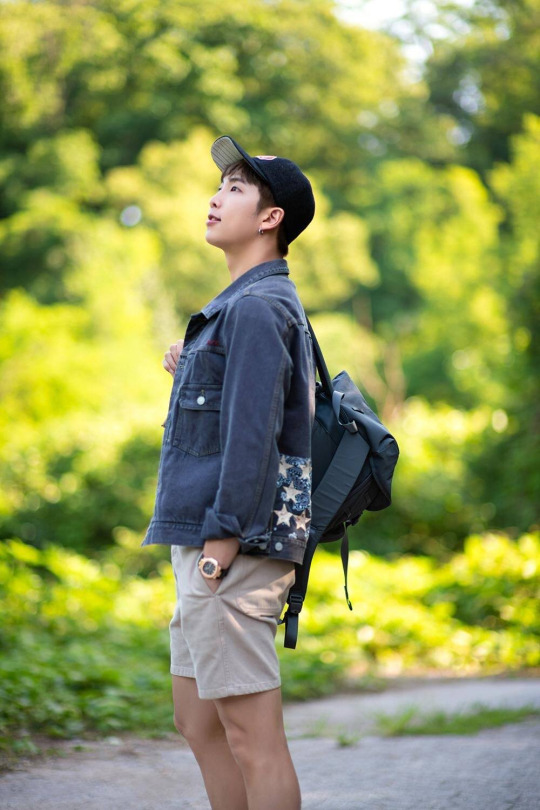
JOURNEY
you and joon have been pretty close friends since you first came to this new highschool. your family has been moving around a lot, so you never stayed long in any schools, until this one.
your mom eventually got to know namjoon’s mother and they became friends as well.
there were always some activities for your class, and one day it was a trip for the whole day, where teachers took all of you to the place that was very similar to some kind of jungle.
it was no surprise to find this type of surroundings in australia, so nobody was really super stoked by it.
but the exciting part was, that your main partner for the day was joon, and together you’d get lost, just enjoying each other’s company.
to avoid punishment, joon took the situation under his control and called the teacher in charge, bluntly lying about the fact that you two have gone home already. you two didn’t mind spending more time together, especially in this beautiful scenery.
after all you’d find your way out of there and joon would walk you home from the bus station, because it already got dark, and he would give you his grey jacket, because you said under your breath a silent, “how much colder can it be..”
your mom was waiting for you on the porch already - pretty mad - and joon took all the blame on himself, apologising and saying that you two got lost because of him.. she actually forgave the both of you and even invited joon to stay for a cup of tea.
the whole time beside the dinner table you couldn’t take your eyes off him, and he did the same, captivating your eyes with his..
in the hall you were just simply talking about how much fun the whole day was and you both ended up in a warm hug towards the end of your conversation.
since you’re both still underage, your mom makes a firm statement that she will drive namjoon to his own home and as you waved him goodbye you were smiling, because.. damn, he forgot to take his jacket back from you. and you couldn’t help yourself but realise that it smelled just exactly like him.. like home.
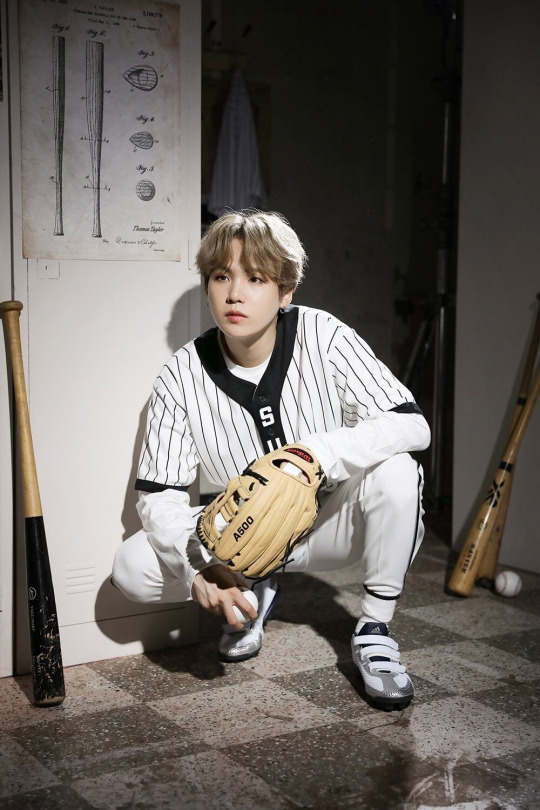
PERFECT
yoongi was this perfect friend. you didn’t know him for too long, but it didn’t matter. your personalities clicked and you started to spend a lot of time together.
he was the best baseball player in the whole school and you were fortunate enough to always be by his side, whenever some victory happened.
but what you missed on - in the early stages of your friendship - were the losses, the bad things that happened.
one day you were just passing by the slightly opened door of the changing rooms, when you heard a slight whimper.
you immediately stopped and carefully peeked through the crack, trying to inspect who’s inside.
you saw light hair and a small posture, crouched on the floor near the lockers, shuddering their shoulders, with arms wrapped around their knees, as they desperately tried to hide the sounds that sometimes escaped their lips.
it didn’t take you long to realise who it was..
“yoongi?..” you called, softly, opening the door further and making your way inside.
“i fucked it up.. i fucked it all up,” was all he said, burying his head even tighter to his knees.
so he wasn’t perfect, after all, huh? everyone kept painting yoongi as this cold and professional kid, but they just never got to see the more emotional and vulnerable side of him.
perhaps he didn’t let them see it.
didn’t want them to see it.
but he let you. and when you dropped down on the floor next to him, consoling him and patting his hair, he let you.
when you leaned towards him, he started to cry even harder, letting his emotions out, and finally felt how it was to be truly supported by someone.
that’s what true friends do, right? being here for each other in good and bad times.
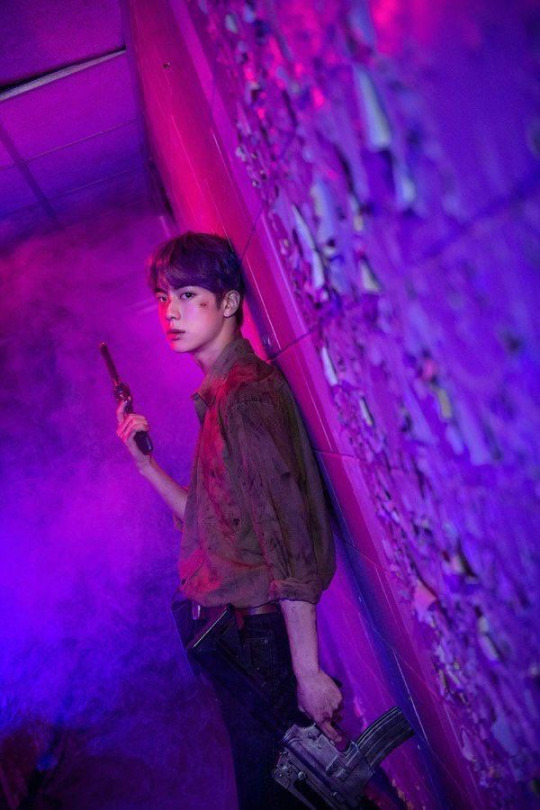
ZOMBIE
it was the end of it all. the world has gone insane since last week, when a massive zombie virus broke out... somehow.. to the whole world.
Nobody knows exactly what or how it happened, but even though everyone was fairly “educated” on the apocalypse matter from all the movies and books, loads of people were still getting turned on a daily basis.
in other words, it was terrifying, and not as adventurous as in the fiction.
you were fortunate enough to find yourself, after days on the road, in the abandoned house, still filled with some leftover foods around.
you just did your evening routine and came back to your “room”, where you stood by a small window, looking out and trying to concentrate your attention on the lightest of sounds.
and you finally heard it. a zombie was approaching from the hallway, their grunting clear as day for your careful hearing.
you had no weapon, no help around..
you didn’t know exactly what was your plan, but.. something will have to do.
you grabbed the nearest brick into your palm and squeezed hard, getting nervous.
the undead person already came into the view, feeling your presence and moving in your direction.
when there were only a few meters between the two of you, the gunshot blazed through the air.
the body fell to the floor and you saw a man standing in the hallway, rifle in his strong hands.
“hey.. you okay?” a man said, fixing his freshly dyed purple hair.
“yeah..”
“good. i think you could use a friend in this apocalypse,” a man smirked and gave you a bag with some food, by this making a peace pact between you.
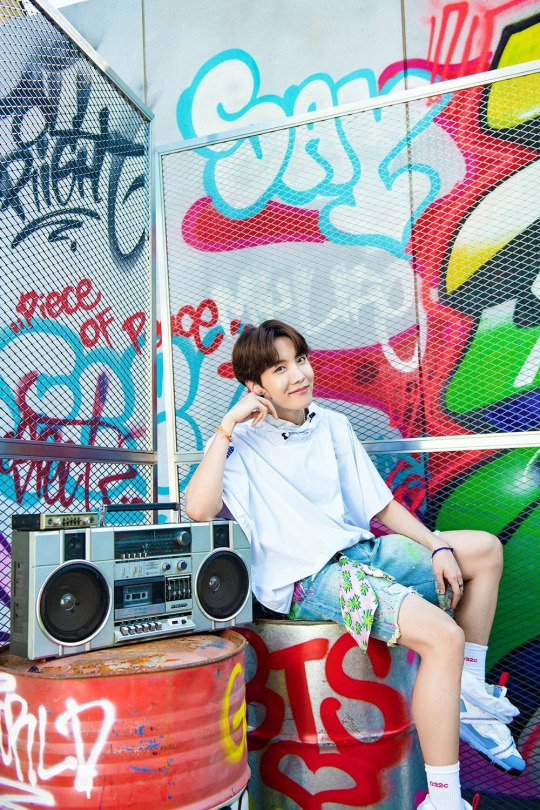
STREET
hoseok was an international student from korea, who was studying art and dancing majors.
you were friends for some time already, but both of you never had time to actually hang out outside of the school grounds.
you were into filmmaking and your study hours were crazy, to say the least.
but finally, summer holidays were approaching. you didn’t make any plans, because most of your friends went travelling, and your buddies from the dorms were supposed to leave to go back to their lovely families.. you just didn’t have that.
one of the final days of the semester before the big break, you were just wandering around the campus, finally having nothing to do, after months of hard work..
and suddenly your phone rang. it startled you, on the screen showing “hoseok” with his number underneath it.
you picked it up, of course.
“hey, are you in town?” you heard an exciting tone on the other end.
“yes, actually..”
“wanna hang out? come to that park near the school, in 20 minutes?”
and it was settled. when you dragged your ass over there, you came perfectly on time and hoseok was already waiting for you, sitting on top of the many big cans that were laying around here.
he simply handed you the graffiti colour. you couldn’t help yourself but to make a surprised expression, but took the paint anyways.
“let’s create something!” he exclaimed, jumping to his feet and started to dance around, filling the walls with some slogans and pictures of all sorts.
he noticed you hesitating at first, and gently put his elegant hand on your back.
“heyy, don’t be afraid, it’s my first time with this kind of medium too! i just figured we could do something for the first time together and not worry about the result that much, most important thing is just having fun, isnt it?” he smiled at you warmly, and you just couldn’t help it and put your arm towards the wall, spraying his name on it.
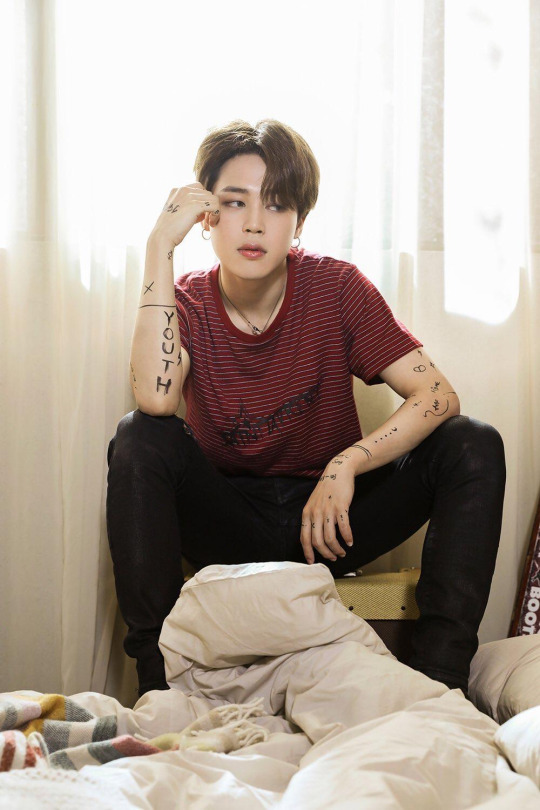
YOUNG
it was one of those days, when everything seems quiet, slow and kind of lazy.. it was just another weekend in your small city, far far away from all the excitement of the bigger metropolis.
you were fortunate enough to meet one of the closest people in your life here, though.
you came over to jimin’s place, as you have previously agreed on.
he made you some tea. kettle boiled in the silence of his apartment and you smiled at each other, when he picked your favourite kind.
you knew each other well. and jimin knew even better about your current struggles, as of the problem that you’re trying to become a tattoo artist, but it wasn’t quite working out yet.
he was always trying to help and make things better.
so when you ended up in his room, he took out a marker from his pencil-case and showed it to you, excitedly.
“what should i do with it?” you chuckled, but sadness still prevailed on your face.
“draw on me,” he simply said and put the tool firmly into your hand, “imagine i’m the canvas and you’re about to ink my skin.”
“okay..” it seemed a little weird and embarrassing at first, but after a while you both got fully into it and your passion literally blossomed in front of his eyes and reflected there as beautiful sparkles.
“youth?..” he asked, looking at his arm, with a genuine warm smile.
“youth. let’s never forget about this. when we’re still young, you know?” you smiled and then jimin started laughing with his angelic voice.
“i like it! write more, please..”
you ended up writing things like “i me”, “happy song :)” and a big “nevermind” in some really rough, but pretty font on his ribs.
“i really like this one..” jimin said, truly amazed.
and a few years later, after you’ve finally made it out of the small town and owned your own tattoo studio, jimin came with a request of nevermind on his ribs.
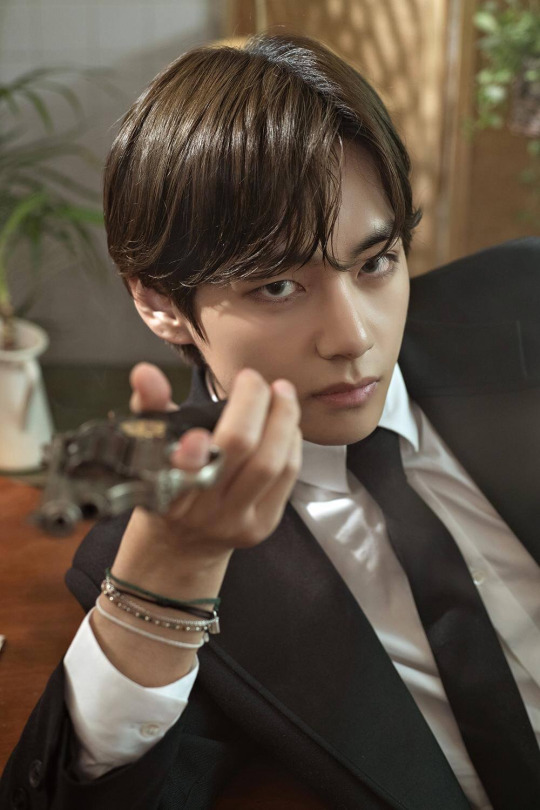
MAFIA
it was really risky to try and accomplish this mission and you knew it.
there were literally myths and stories going around this mafia, especially their leader.
nobody never described how he looked, just that he was ruthless and never spared their enemies.
all the other heads of gangs had exceptions for some people, but not him.
and when you were caught, illegally transporting some dangerous.. “items” by one of his people, you were immediately captured. this wasn’t supposed to happen and now you knew your fate.
you were held hostage for some days, but now you’re finally on the way to meet the master head behind all of this.
you were pushed into this luxurious room, doors closing loudly behind you. but it was empty..
after the uncomfortable silence the backdoor of this strange place opened and you saw him come in.
his expression was grim and intimidating, but changed in a heartbeat when your eyes met.
“taehyung?..” your voice cracked in between the pronunciation of his name and you were just.. astounded.
you were close friends until last two years, because you suddenly lost contact with each other.
“are you okay?” he immediately rushed to you, uncuffed your hands and wrapped you in a warm hug, dropping his stern facade this instant. in that second all your memories from when you were younger and just having fun together popped up in your head and you couldn’t help but only hug him tighter.
when you pulled away after a while, you cupped his cheeks with your hands and stared into his eyes, “how the fuck did you get into all of this mess?”
you just wanted him to stay this innocent and pure boy you always knew..
“i should ask you the same thing then,” he frowned his brows and pouted.
“i guess we’ll have to figure it out somehow..” you turned your head towards the doors, that slowly clicked as someone was clearly ears dropping you.
“now it’s only you and me, partner.”
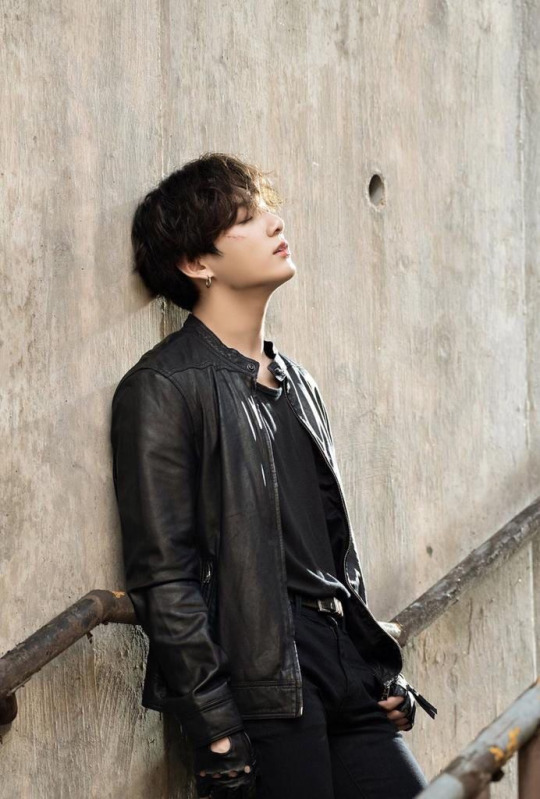
MESSENGER
you were just an ice cream truck worker, giving out yet another frozen treat to a happy family in front of your face. ugh. you didn’t like your job one bit. but what can you do in summer, when you don’t have enough money from your usual income like drawing or writing articles, right? next second you look up from your phone and another customer is standing there. “can i get some ice, please? just ice,” he says firmly and tries to keep up a smile, but it breaks a few times, because the man looks genuinely injured on the side of his head. “are you sure? you should call a doctor for that-“ you can’t even finish your sentence when he just pulls his hand into the ice-cubes container himself and pushes it against his temple, part of the ice melting and some of it falling down. suddenly he’s checking his phone and then frantically looks around, not loosing his cool image. then his eyes dart back at you and he says, “do you think i can hide behind the truck? you’d still stand there so its not suspicious that the truck is here by itself?” he really seemed to be in a hurry, so you just nodded your head yes and he was already crouching next to you, in a still position. soon a group of bulky men appeared, coming to you and asking if you havent seen a younger guy with longer brown hair, tattoos and piercings. you have, and he has been hiding just next to your legs. “no, i’m sorry,” you said with an innocent smile and eventually they went away. when the air was clear, the man finally stepped away and most adorable smile appeared on his face. he was holding a small transparent package, full of white crystals. from all the happiness he kissed the package and then patted you a little awkwardly on the shoulder. “thank you so much for covering me. i’m jeongguk, by the way,” he stretched his tattooed arm towards you and you shook hands. “can i get an ice cream now?” he said, a little bit embarrassed, as he stood in front of the truck now, like a normal customer.
#namjoon x reader#seokjin x reader#yoongi x reader#hoseok x reader#jimin x reader#taehyung x reader#jungkook x reader#bts x reader#bts fanfic#bts fanfiction#bts army zip#army zip#army zip 2020#bts drabble
46 notes
·
View notes
Text
Eleanor Spiess-Ferris: Daphne’s Sister
She’s a purveyor of vision, and leads us on a merry chase after, well, ourselves -James Yood, Eleanor Spiess-Ferris: An Appreciation, Sorrow of Swans, 2009
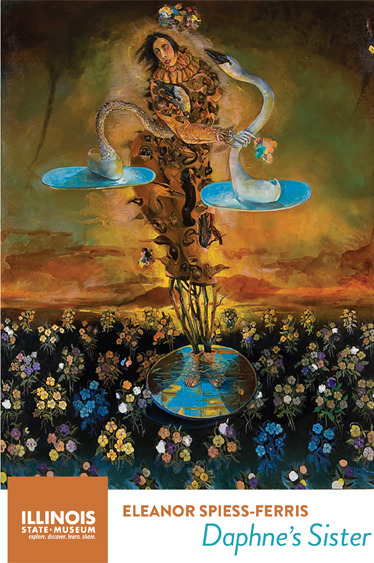
Eleanor Spiess-Ferris: Daphne’s Sister
Eleanor Spiess-Ferris (b. 1941, Las Vegas, NM. Resides, Chicago IL) is known for her distinctive approach to the figure, almost always women, who perform in dramatic settings. Her women are divas: larger than life, central to the story, and, like all good heroines, troubled by adversaries and circumstance.
Spiess-Ferris’s attention to the narrative body has deep art historical roots. Major influences are the visionary paintings of Hieronymus Bosch; Mannerist and Baroque arts attenuation of form and emotional atmosphere; Symbolist and Surrealist approaches to the fantastic, unreal situation and Feminist thought in the conflation of personal and political realities of women through history. Spiess-Ferris’s work is part of a strong tradition of figurative painting in the Midwest, which includes her contemporaries, Phyllis Bramson, Robert Lostutter, Tony Phillips, Christina Ramberg, and Suellen Rocca, along with modernist artists such as Gertrude Abercrombie, Ivan Albright, and Seymour Rosofsky.
In addition to her exploration of the figure, Spiess-Ferris also turns to the natural world for source material and inspiration. Her work is filled with birds, animals, flowers, trees, and water; constant companions and characters that help narrate the intertwined connection of humanity and nature. The questions of what animates and motivates us, as well as the consequence of our actions on the natural world, are central to her work.
This exhibition traces the development of Spiess-Ferris’s distinctive figures over 40 years of painting and drawing, often comparing studies and sketches with her final works. Spiess-Ferris has been drawing from a live model since the beginning of her career; an essential practice for her experimentation with the narrative figure. Her life studies often transform into their mythic selves in the process of a drawing session, shifting from observation into invention through distorting proportions and imposing natural forms as essential elements of the body.
Doug Stapleton, Associate Curator of Art, Illinois State Museum


(installation views: Eleanor Spiess-Ferris: Daphne’s Sister, Illinois State Museum, Springfield, IL, October 26, 2019 - February 16, 2020)
…[T]he shift we undergo from our world to her world, the immersion into some parallel universe when nature, animals, and humans all exist, just as we think we know them, but now functioning as integers in surprising and evocative narratives of mystery and wonder …’ —James Yood, Eleanor Spiess-Ferris: An Appreciation, Sorrow of Swans, 2009, exhibition catalog
The exhibition title Daphne’s Sister references the ancient Greek story of the nymph Daphne, who is transformed into a laurel tree to save her from the god Apollo’s unwanted advances. Spiess-Ferris never names Daphne in her work, but the suffering and endurance at the crux of Daphne’s story resonates through it. Spiess-Ferris’ figures are often depicted as hybrid creatures part human and part tree or bird, acknowledging shape-shifting as a strategy for survival. What is important in Daphne’s story is not that Apollo claims the laurel tree as his emblem, but that Daphne survives and thrives as a new species.
This painting, Fecundity, 2013, is a Daphne-like figure. She is a hardworking woman; balancing twin swan filled pools in a field of pansies while standing on delicate twig legs. She is between being and becoming, harboring life in her hands, but cautiously eyeing two approaching funnel clouds. If fecundity is a powerful productivity, then it is difficult, precarious work. The painting asks how we keep our balance, our sense of right and wrong, in relationship to all that we juggle.

Eleanor Spiess-Ferris, Fecundity, 2013, Oil on linen, Courtesy of the artist. ©Eleanor Spiess-Ferris

Eleanor Spiess-Ferris, Study for The Marauders, 1989, Graphite and colored pencil on sketchbook page, gift of the artist, 2018.41.59. ©Eleanor Spiess-Ferris
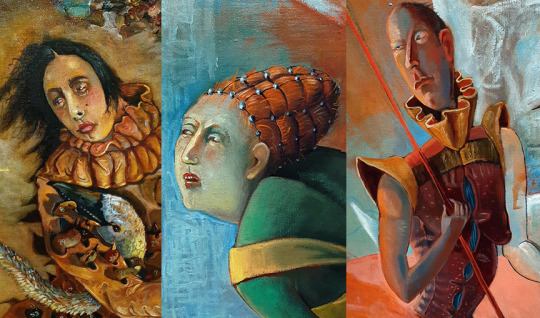
Figures are the essential storyteller in Eleanor Spiess-Ferris’s work. As such, the artist is more interested in how she can exaggerate her figures, bending, twisting and enlarging the forms to emphasize the emotional content of the work. Likewise, Spiess-Ferris is equally versed in rendering the figure with life-like realism. She has been involved for decades with the Evanston Figurative League, a group of artists who regularly draw from the figure as a means of honing their drawing and observational skills. Throughout the exhibition are examples of her drawings from the figure, which seem to stand in contrast to the exaggerated figures seen in the final paintings. Yet all of these images, from the quick contour sketch to the several hour-long poses from a model, speak to her understanding of how skin and bone, posture and gesture, can carry emotion and meaning. For her, imagination comes from observation, the original form elaborated and stretched into strange, new narrative figures.
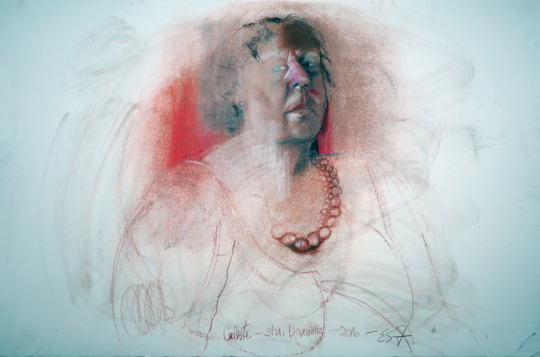
Eleanor Spiess Ferris, Untiled study (Celeste), 2016, Conte on paper, Courtesy of the artist. ©Eleanor Spiess-Ferris

Eleanor Spiess-Ferris, Lily, nd, Mixed media on paper, Courtesy of the artist. ©Eleanor Spiess-Ferris

Eleanor Spiess-Ferris, I Met a Rainbow in Argyle, 1976, Oil on canvas, Courtesy of the artist. ©Eleanor Spiess-Ferris
Spiess-Ferris’s paintings are allegories of the tides of fortune and consequence played out in often absurd situations. Her cast of characters includes clowns, ghosts, swan women, goddesses, suited skeletons, hobby horses, scarecrows, and crows. Spiess-Ferris’s figures are sometimes the main character, other times they are bystander or victim, pecked at by scavengers or poked and prodded by Picadillos—clownish demons. Who are her companions—these beasts and birds that accompany and sometimes inhabit the figure—and what is their part in the drama? They represent our interconnection, our intertwined fate with the natural world. They accompany the heroine on her many journeys; the birds are her voice; the demons are the embodiment of the consequence of our actions on a world turning uninhabitable.
These characters inhabit various worlds. In her early paintings from the 1980s and 1990s, you find them in stage-like settings with the curtains pulled back, revealing a tumbling operatic scene. In her later work, her figures move out into the world, floating in dark watery expanses or dwelling deep in the forest, more of residents now than actors passing through the scene.
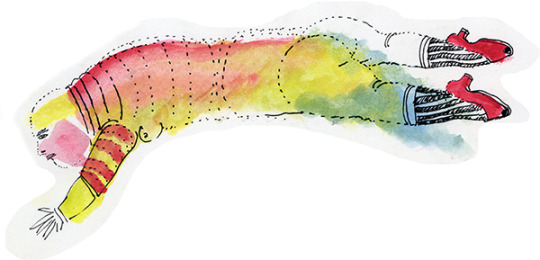
Spiess-Ferris’s earliest figures from the 1970s are rendered quickly, with a strong outline, minimal detail and broad strokes of color. These figures draw deeply on her childhood memories of northern New Mexico, especially the religious processions of the Spanish Penitentes and the ceremonies of the Pueblo Indians. In particular the sacred clown in Pueblo belief, a trickster who uses humor to make social commentary, has had a lasting impression on Spiess-Ferris’s figures. Northern Renaissance painter Hieronymus Bosch’s narratives scenes of Christian morality, heaven and hell as grotesque, carnival-like spectacle, also informs her work. These influences find bearing in her earliest paintings, such as the rainbow figure of I Met a Rainbow in Argyle and likewise in the drawing collage, Heaven, No Exit.
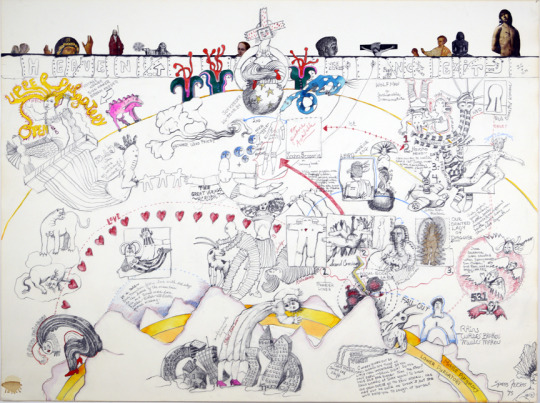
Eleanor Spiess-Ferris, Heaven No Exit, 1975, Graphite, color pencil, marker and collage on paper, Courtesy of the artist. ©Eleanor Spiess-Ferris

Eleanor Spiess-Ferris The Gray Room, 1980, Oil on canvas, Gift of the artist, 2009.26. ©Eleanor Spiess-Ferris
Spiess-Ferris's figures are rarely whole creatures. They are often depicted as fragments of a body or as hollowed skin or shell. The question of what animates us is central to her work. Is our outward appearance—how we present ourselves to the world—the true reflection of our inner life or just a costume we wear?
In Gray Room, 1980, Spiess-Ferris critiques the difficulty for women in finding their bearing and balance in a world where they are seen as sexual fantasies. The true person is not seen, only her ghost of a form, dressed up outlandishly. As a young artist finding her artistic voice, she used this ghost form repeatedly in her early work as an appraisal of female identity.
The idea of clothes animated to appear like human forms stem from Spiess-Ferris’s childhood memory of seeing clothes blown off a clothesline and caught up in tree branches. The clothes appeared to be alive as they billowed in the wind, as if the trees were dressing up to be recognized as human.

Eleanor Spiess-Ferris, Wild Sticks, 1982, Oil on Linen, Courtesy of the artist. ©Eleanor Spiess-Ferris
The memory of family from her New Mexican childhood inspire Spiess-Ferris’s Wild Stick figures, which are part of a series recollecting the daring exploits of her Aunt Maggie on horseback as well as her own memories of riding her palomino horse Snake. The memories—faded with the years and informed by pressing issues of adulthood—become ghost women riding hobby horses in a raucous race. Hobby horses symbolize a repeated activity—something we return to again and again—and these figures seem to be endlessly, urgently racing through time and space.
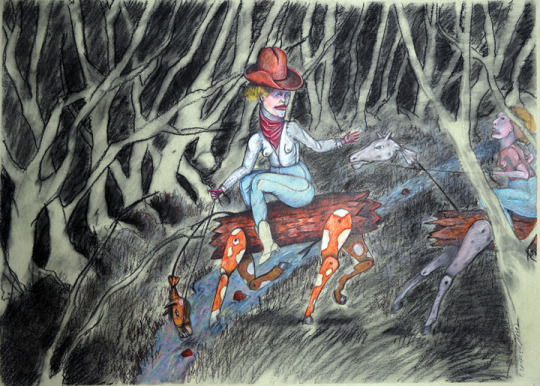
©Eleanor Spiess-Ferris
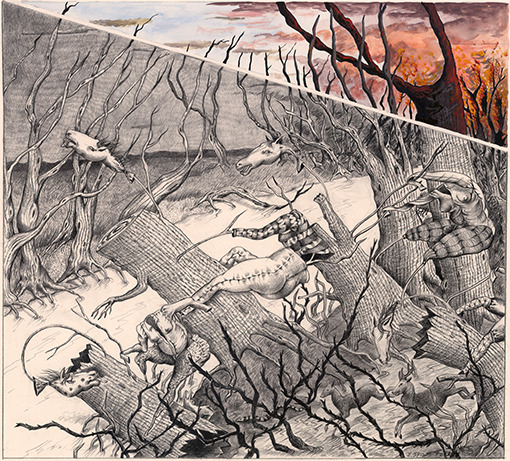
Eleanor Spiess-Ferris, Study for Wild Hunt, c. 1980s, graphite and gouache on paper, Gift of the artist. ©Eleanor Spiess-Ferris

Eleanor Spiess-Ferris, River, 2012, Oil on canvas, Courtesy of the artist. ©Eleanor Spiess-Ferris
Birds are a constant companion and inhabitant in Spiess-Ferris’s work; their chorus is its voice and breath. Birds inhabit the figure, nesting and finding protection in the limbs or the folds of the body. In River, 2012, they are an exposed nerve, a life force on a string held suspended above flowing time. James Yood wrote, ‘Birds are almost everywhere in her work as well, preening, pricking, nesting, cavorting, instinctive foils for the humans they abut, in their lust and vanity and hunger to survive becoming just like us.*’
* James Yood, Eleanor Spiess-Ferris: An Appreciation, Sorrow of Swans, 2009

Eleanor Spiess-Ferris, Tears, 2007, Oil on Canvas, Courtesy of the artist. ©Eleanor Spiess-Ferris
Eleanor Spiess-Ferris’s paintings balance absurdity and compassion. At first glance, we recognize their theatricality: outlandish costumes and hairstyles coupled with contortionist poses and dramatic lighting, which give the appearance of high comedy and satire. But the central storytelling brings us back to our own humanness and to the natural world, especially our relationship with water. There is a strong liaison with water—tears, sorrow, and regeneration—in Spiess-Ferris’s work, but rarely is this element single-purposed. In Tears, 2007, weeping women cry into vials that than pour out on the land, flooding the landscape. One woman offers small candle boats as an act of remembrance, while another carries her ancestors floating in her bowl-shaped head. In an interview, Spiess-Ferris explains,” Grief is not just totally bad—something comes out of it. … [S]he creates …by crying …she creates the environment in which the birds and things can exist through her grief. She’s an ecosystem. And she cries and will forever cry, but with her tears comes life.” *
*Gavin Van Horn, 2013, June 7, The Artist Who Would Be Crow, Center for Humans and Nature, www.humansandnature.org
Spiess-Ferris’s figures, armored and constricted in cloth as tight as skin, bristle in quilted or scaled discomfort. Bodies twist and double over or distort to resemble strange bug carapaces, as in A Small Sound, 2016. Deliberately distorted, these figures act as a visceral reminder of how we feel emotions in our bodies. There is something powerful in the contorted figures, which, like clowns and jesters, use absurdity to drive home a pinprick of recognition of ourselves.

A Small Sound, 2016, Gouache on paper, Courtesy of Audrey Niffenegger. ©Eleanor Spiess-Ferris

Eleanor Spiess-Ferris, The Chair, 2010, Gouache on paper, Courtesy of the artist. ©Eleanor Spiess-Ferris

Eleanor Spiess-Ferris A Mama’s Tears (study for The Chair, 2011), n.d. (c.2011), graphite on paper, Gift of the artist. ©Eleanor Spiess-Ferris

Eleanor Spiess-Ferris, Islands, 2004, Oil on Linen, Courtesy of the artist. ©Eleanor Spiess-Ferris
In Islands, 2002, garland-wreathed heads float as a silent procession in a sunken, twilight world, each person calmly surveying the darkness by the light of a powerful spirit lamp. Are these heads the islands of this title, or is the island our collective humanity afloat in a larger world full of unknowns? Some figures sport elaborate collars or wreaths of flowers around their neck, while another wears a wooden dunce hat full of birds. In the middle, one man balances a single white lily stalk, symbolizing the Virgin Mary—the compositional centerpiece of this procession of hope and mercy. ‘The theme of caretaking strongly transmits,’ writes nature and ethics scholar Gavin Van Horn. ‘There is a guarded optimism in the organic intertwining of human and nonhuman life, in which heads become lifeboats, thoughts become branches filled with song and chatter, and bodies are pierced and re-aggregated into something greater than their parts.*’
*Gavin Van Horn, 2013, June 7, The Artist Who Would Be Crow, Center for Humans and Nature, www.humansandnature.org

Eleanor Spiess-Ferris, Inflated Ego, 2008, Oil on Canvas, Courtesy of the artist. ©Eleanor Spiess-Ferris
I wish there were better words to describe the emotional tenor of a work by Spiess-Ferris, melancholic, brooding, wistful, heartfelt, poignant, tragic, tender, etc., none fully does the trick, but in some combination, help to gauge the psychological temperature that she regularly achieves. The complex Inflated, Egos, 2008, is so diverse and rich, it takes us to a place of dreams and nightmares, fireballs cascading from the orange and apocalyptic sky while, in a sliver of blue water, a few of Spiess-Ferris’s signature actors and actresses float about on or among some very expressive swans. There’s a hothouse and claustrophobic feeling here, we see broad areas of suggestive emptiness juxtaposed with an intense but ambiguous narrative episode. Why are these curiously costumed individuals sailing about, … sporting inefficient and symbolic umbrellas and the like… what is their relationship to one another, are they vulnerable or somehow self-contained? More questions than answers, as is often true in this artist’s work—but images such as this provide that aperture to wonder and imagination that invite us to speculate and fantasize, to question and, finally, to surrender.
James Yood, Eleanor Spiess-Ferris: An Appreciation, Sorrow of Swans, 2009
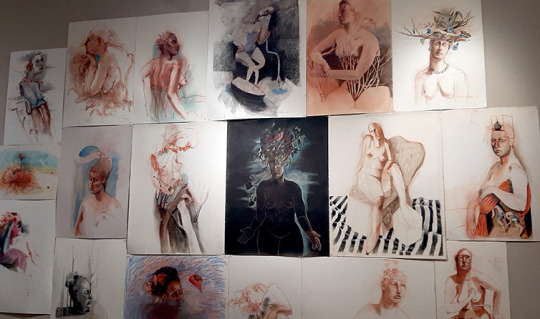
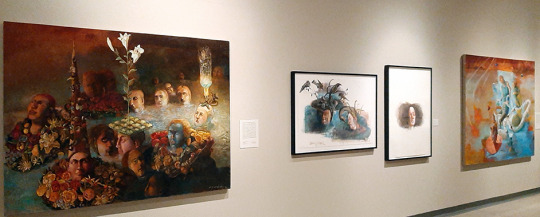
(installation views: Eleanor Spiess-Ferris: Daphne’s Sister, Illinois State Museum, Springfield, IL, October 26, 2019 - February 16, 2020)
Additional images

Eleanor Spiess-Ferris, Autumn, 2002, Oil on linen, Courtesy of the artist. ©Eleanor Spiess-Ferris

Eleanor Spiess-Ferris, Untitled Figure study, Nd., Conte on paper, Courtesy of the artist. ©Eleanor Spiess-Ferris

Eleanor Spiess-Ferris, Gathering Swans, 2002, Oil on canvas, Courtesy of the artist. ©Eleanor Spiess-Ferris
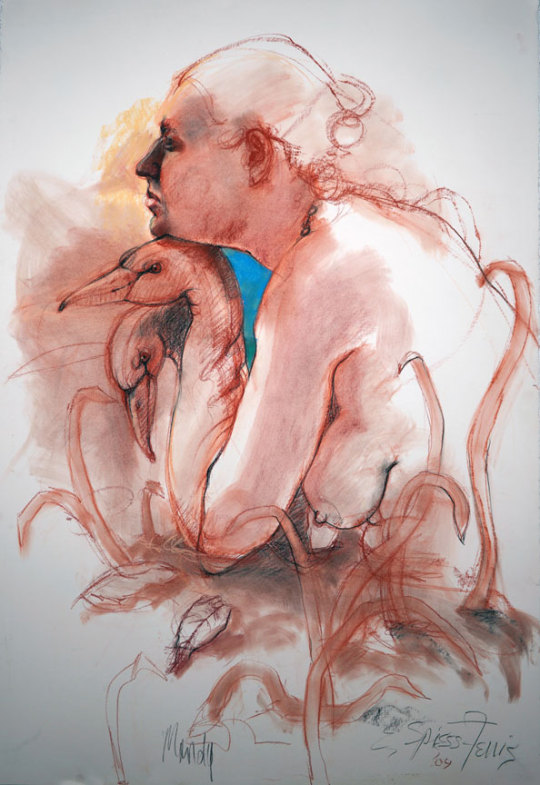
Eleanor Spiess-Ferris, Untitled study (Mandy), 2004, Conte on paper, Courtesy of the artist. ©Eleanor Spiess-Ferris

©Eleanor Spiess-Ferris
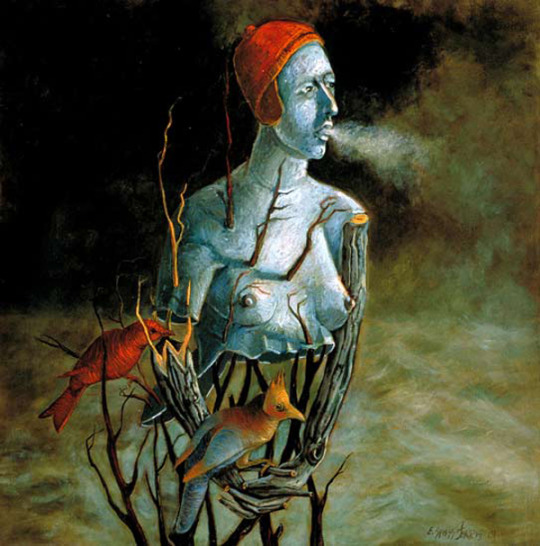
Eleanor Spiess-Ferris, Those That Were Left Behind, 2002, Oil on canvas, Courtesy of the artist. ©Eleanor Spiess-Ferris
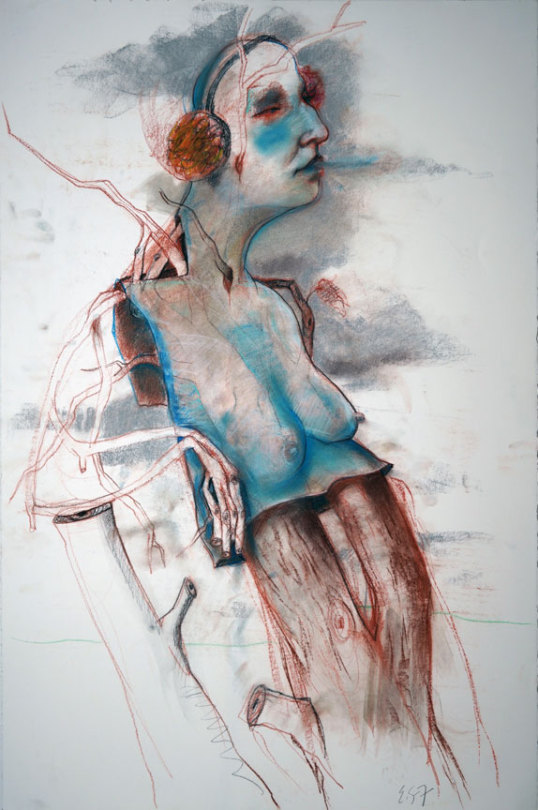
Eleanor Spiess-Ferris, Untitled study (related to Those That Were Left Behind, 2002), Nd, Conte on paper, Courtesy of the artist. ©Eleanor Spiess-Ferris
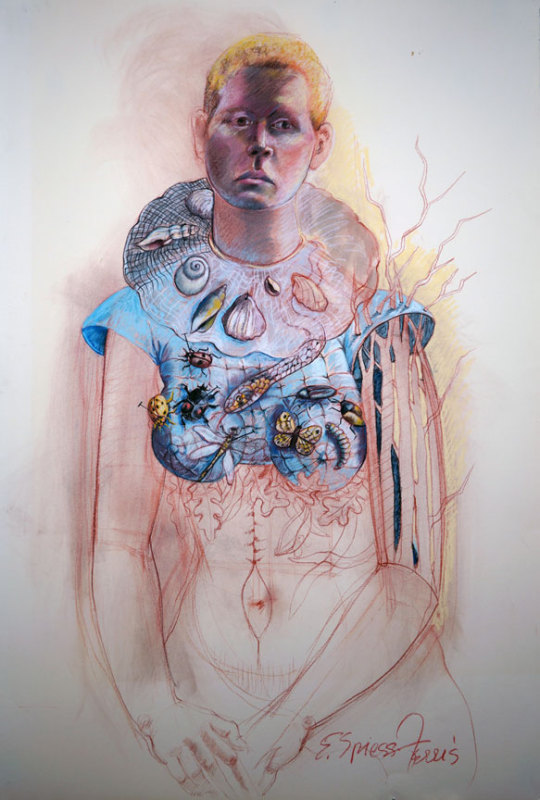
Eleanor Spiess-Ferris, Untitled (related to figure in The Basket, 1993), 1990s, Conte on paper, 30 ¼ x 44”, Courtesy of the artist. ©Eleanor Spiess-Ferris
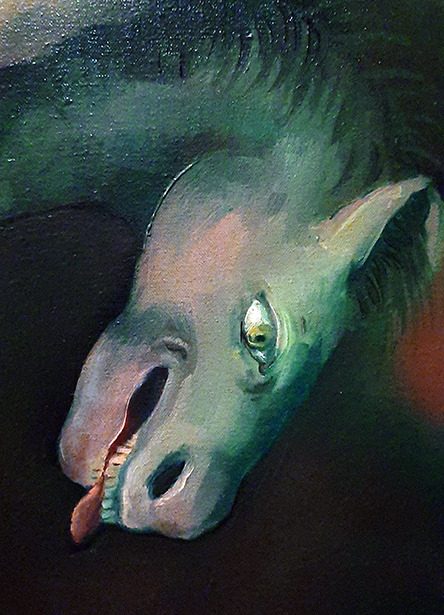
©Eleanor Spiess-Ferris
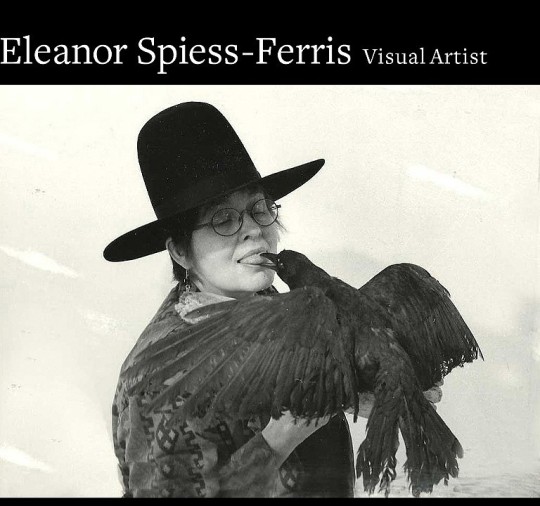
Eleanor Spiess-Ferris: Daphne’s Sister was presented at the Illinois State Museum, Springfield, IL, October 2019 - Feburary 2020, and at the Evanston Art Center, Evanston, IL, March 2020.
0 notes
Text
Hyperallergic: No Point of View Is the Best View of All: Artists Working Between 1952–65, Many of Whom Are Forgotten
Jean Follett, “3 Black Bottles” (1958), mixed media on wood, 11 2/3 x 19 1/2 x 1 3/4 inches, The American College of Greece Art Collection, Athens, gift of Takis Efstathiou Photo: Nicholas Papananias
Once upon a time, the art world — at least as it existed in downtown New York in the 1950s — was diverse in myriad ways. I mean, when is the last time you went to a big group show and came across a gaggle of Asian sounding names: Yayoi Kusama, Leo Valledor, Yoko Ono, Nanae Momiyama, Robert Kobayashi, Walasse Ting, and Tadaaki Kuwayama. How many Asians were included in The Forever Now: Contemporary Painting in an Atemporal World, which was at the Museum of Modern Art in New York (December 14, 2014–April 5, 2015)? What happened between the mid-1960s and the present, a little more than a half-century? Did Asians stop painting and go into computer programming? Hollywood erases Asians faster than you can say anime, and so does the art world, it seems.
These are just some of the questions spurred by the exhibition, Inventing Downtown: Artist-Run Galleries in New York City, 1952-1965 at the Grey Art Gallery, New York University (January 10–April 1, 2017), which was curated by Melissa Rachleff, who has done an amazing and thorough job.
Rachleff deserves our thanks for amassing a wide and wild range of material, from art works to documentary photographs to gallery ephemera. She has managed to allot discrete areas to a variety of artist-run galleries and groups in what is a difficult space to organize. Rachleff seems to have left no stone unturned. Driven by curiosity, this is curatorial practice at its best.
For anyone who has come across the name Jean Follett, you can see two wall pieces by her in this exhibition, one of which is in a little-known collection in Athens, Greece. Follet, who studied with Hans Hoffman, began applying layers of paint to found objects placed in a shallow box, to which she added more objects. They are shadow boxes but they are not. They don’t look like anything else. They are hybrid works, but that term does not touch upon the strangeness of Follet’s art.
Follet was included in three shows at the Museum of Modern Art between 1959 and 1963, including The Art of Assemblage (October 4 – November 12, 1961), organized by William C Seitz. That catalog was the first place I saw her work, along with a number of other artists, including Bruce Conner, Jess, and Robert Mallary, alongside Lee Bontecou, Joseph Cornell, Marcel Duchamp, Jasper Johns, Marisol, and Robert Rauschenberg. That kind of openness to different aesthetic positions does not happen anymore.
I don’t know what happened to Follet, but I have long been curious about her work, and was more than happy to see it. Forty years ago, Thomas B. Hess mentioned her in passing in a review of the painter David Budd that appeared in New York Magazine (March 7, 1977). Here is the kicker line from that review:
Some lost their way. Where are Jean Follet and Felix Pasilis? A few died before their time (Gabe Kohn, Sam Goodman, Gandy Brodie). Most have persevered, however, in lives of not quite quiet desperation. They teach a bit, exhibit now and then, while slowly piecing together the historical puzzle that was scattered so brusquely about fifteen years ago, when it seemed, as if on a Monday, they were respected members of a cultural milieu and then, the next Friday, practically the whole art Establishment crossed the street to avoid having to say hello.
Hale Woodru, “Blue Intrusion” (1958), oil on canvas, 70 x 40 inches, Grey Art Gallery, New York University Art Collection, anonymous gift, 1958.35. Art (© Estate of Hale Woodru /Licensed by VAGA, New York, NY)
Hess writes that this sweeping change took place around 1962. All the artists he mentions have work in the NYU exhibition. I would venture that most are hardly known and the probability is high that none of them have something currently on display in a New York museum.
If 1962 is the dividing line between one art world and what we seem to have inherited — the moneyed domain of the big, slick, well-produced, and shiny, not to mention the big, industrial, and tastefully rusted — Inventing Downtown will bring you back to the period before the “art Establishment crossed the street.” It is before the art world became arty.
Between 1952 and ’65, the years covered by the exhibition, every kind of scene seemed to be percolating in a rather small geographic area of Manhattan. The epicenter was East Tenth Street, where a bunch of artist-run galleries opened and Willem de Kooning had a studio. Ratleff smartly organizes the shows around artist-run galleries, alternative spaces, and groups. Some were short-lived. Spiral, a collective of African-American artists who met in Romare Bearden’s loft on Canal Street, was active from the summer of 1963 until 1965, and had one exhibition. They were trying to negotiate their relationship to race, Civil Rights, and aesthetics. It could not have been easy. Ratleff also includes the Green Gallery, whose “program,” according to the free brochure accompanying the exhibition, “resulted in the narrowing of aesthetic possibilities and the marginalization of many artists.” If she left any gallery or alternative scene out, I am unaware of it.
In addition to Follet, there were many artists whose work I hadn’t seen before. There were also many surprises from familiar artists, including a garish, Bonnard-inspired “Portrait of Frank O’Hara” (1953-54) by Wolf Kahn. It looks as if the poet is wearing a pink and orange Halloween mask. A few feet away, on the same wall, is a lovely “Portrait of Jane Freilicher” (1957) — a close friend of O’Hara’s — by Jane Wilson. We know the portraits of O’Hara done by Larry Rivers, Fairfield Porter, and Alice Neel, but this one was new to me.
There are also early works by Jim Dine, Dan Flavin, and Allan Kaprow before they became famous for making signature works. Flavin’s piece “Apollinaire wounded (to Ward Jackson)” (1959), is made from a crushed can surrounded by oil paint and pencil on Masonite, mounted on plaster on pine in a shallow box. The title is carefully incised into the paint in the upper left corner, while the red hole at the top of the crushed can refers to the poet’s head wound, which he got in World War I.
Dan Flavin, “Apollinaire wounded (to Ward Jackson)” (1959–1960), crushed can, oil, and pencil on Masonite, and plaster on pine, 13 1/2 x 19 3/8 x 7/8 inches, collection of Stephen Flavin (© 2016 Stephen Flavin/ Artists Rights Society (ARS), New York)
There are abstract paintings by the African-American artists Norman Lewis, Hale Woodruff, and Ed Clark, which tell us that the legacy of the 1960s is one of exclusion. That this exclusion began during the Civil Rights movement does not speak well of the art world.
The other thing that struck me is the diversity of the work. There is no hierarchy between figurative and abstract paintings, nor are there distinctions about materials or processes. The thickly painted “Heaven and Earth” (1960) by Alfred Jensen is diagonally opposite the thinly painted “Ada Ada” (1959) by Alex Katz. The former is filled with arcane symbols, while the latter depicts the artist’s wife twice, wearing a plain blue dress and matching blue shoes. While Hess never says what led up to the sea change in 1962, one cause seems to have been the advent of hierarchical thinking. So you have Donald Judd writing in his essay “Specific Objects” (1965):
The main thing wrong with painting is that it is a rectangular plane placed flat against the wall.
And while this might have influenced the thinking of a lot of people, it does not mean he is right: it means that he has a forceful viewpoint powerfully expressed in unequivocal terms. But you can also find the paintings of John Wesley at the Judd Foundation in Marfa, Texas, and so maybe he was not as much of an ideologue as some people want to believe and take comfort in, because it makes looking easier when you know what to look at. Then there is Clement Greenberg’s snobbish term, “Tenth Street Touch,” which dismissed a lot of artists, including many who did not use a loaded brush or paint the figure. There is the much-ballyhooed claim that art had to be objective, abstract, pure, and even universal — all of which are questionable standards. I think collectors also had something to do with what happened. Whatever the collectors Robert and Ethel Scull did for the art world, they were self-serving narcissists, as Andy Warhol’s portrait “Ethel Scull 36 Times” (1963) demonstrates. And, of course, there’s commerce, from rising rents to the escalating prices of what looks good on a big, immaculate wall — the “post-easel” picture. These forces together helped produce the perfect storm. In some sense, the art world turned from a place of community to a place of authority.
Wolf Kahn, “Frank O’Hara” (1953‒1954), oil on canvas, 43 x 41 inches (courtesy the artist)
By bringing us back to the decade before the “art Establishment” decided what were the true, quantifiable markers of progress, Inventing Downtown reminds us that what we have now was not always the way it was. There are so many things to see and discover — from photographs of interactive paintings by Yoko Ono (Oscar Murillo, eat your heart out), to George Sugarman’s ‘Four Forms in Walnut” from 1959 (yes, you can carve wood and not be old-fashioned), to a strange and interesting “Self-Portrait in Fur Jacket” (1959) by Marcia Marcus (what happened to her?), to a group of gritty drawings by Emilio Cruz, Red Grooms, and Bob Thompson. Check out the work of Boris Lurie, who was in a concentration camp (1941-45), and then read about him and Sam Goodman and the NO! art movement in The Outlaw Bible of American Art (2015), edited by Alan Kaufman. This exhibition brings back a lot of what has been forgotten, overlooked, and thrown under the bus — no doubt with glee. It might not all be good but, to quote another statement that Judd made in “Specific Objects:”
A work needs only to be interesting.
By that standard, everything in this exhibition needed to be in this exhibition. The best thing you can do for yourself is go more than once. Buy the catalogue. Read the brochure while walking around both floors of the exhibition. Open your eyes and mind. Don’t miss the Lois Dodd painting of three cows hanging on the wall above the receptionist. I almost did.
Inventing Downtown: Artist-Run Galleries in New York City, 1952-1965 continues at the Grey Art Gallery, New York University (100 Washington Square East, Greenwich Village, Manhattan) through April 1.
The post No Point of View Is the Best View of All: Artists Working Between 1952–65, Many of Whom Are Forgotten appeared first on Hyperallergic.
from Hyperallergic http://ift.tt/2jl0mD5 via IFTTT
1 note
·
View note
Text
Real Life Ghost Stories: Scary Sleepovers
By J. L. Thurston
Lately, I was chatting with a co-worker of mine. She had recently taken a trip to one of America’s most haunted cities, Savannah, Georgia. Though she had spent good money on a ghost tour, she returned from her trip with no real life ghost story to share with me. However, she did not disappoint. As we spoke, she began to tell me of her teenage years and the strange and terrifying experiences she had during a handful of sleepovers. What she said to me not only sent chills down my spine, but set my pen to paper in a rush to record every detail.
Amanda’s friends were typical, intelligent young girls. They went to school, they wondered about the future, they had sleepovers. But after an encounter with unexplainable happenings and a message from a medium, it would become clear that one of Amanda’s friends was not a typical teenager.
Amanda began telling me about the different strange activity she experienced. During a sleepover, she was beguiling her friends with a retelling of a nightmare.
“I went to the window,” she said, pointing to the very window that had starred in her dream. “And, all on its own, the roll-up blinds shot up! And staring at me from outside the window was… the Grim Reaper.”
Just as the words escaped her mouth, the blinds on the window rolled itself up. The sound of the canvas hitting the window frame sending electric shocks of fear down every spine in the room.
Another sleepover found Amanda and her friends in the basement. A Quija board made of permanent marker and a greasy pizza box sat before them.
“Are there any spirits with us?” one of the girls asked.
The cardboard spirit board did not respond, but a black shadow streaked across the basement wall to the stairs. Gasping, but unable to contain their excitement, the girls raced up the basement stairs after the shadow. At the top sat a little doll, kicked over onto its side. No one could explain what they saw, but they all agreed, it was the creepiest thing they’d ever seen.
So far.
Then Amanda began telling me a story unlike anything I’d heard before. The sincerity of the story, the lingering fear that lived her words, could only lead me to believe she was telling me the absolute truth.
It was another sleepover. Same friends, same antics. The house was newly built, one of the cookie cutter houses in the developing subdivisions. The neighborhood was mostly made of freshly dug earth and halfway completed landscaping. Five of the three story houses were complete. The house had neighbors, but not many. It almost felt like a country home. Isolated.
Amanda was on the computer just outside the kitchen on the first level. The rest of the sleepover was on the third floor. As she was checking her Facebook, she could hear someone moving a cup around in the kitchen. Clunk. A few seconds later another clunk. As though someone was taking one sip at a time and setting the nearly empty cup down hard on the counter between sips.
She quickly went upstairs to be close to her friends. But she did not tell them what she’d heard. She didn’t want to sound paranoid. But one of the other girls went downstairs and returned stating she heard someone moving a cup around in the kitchen.
“I didn’t want to say anything,” Amanda spoke up. “But earlier I heard it, too.”
A general feeling of insecurity began to overwhelm the girls. They were all alone with hardly any neighbors, and it sounded like someone else was in the house.
Quietly, they crept into the bathroom and locked themselves in. One of the girls called the closest neighbor boys and asked if they could come over to check things out.
The boys called back.
“Uh, we can see someone in your kitchen window,” said one of the boys. “Moving around. A white figure.”
Panic began to set in. The resourceful girls began heating up straightening irons, preparing to fight. Breanne, the host of the sleepover, called her mother.
“There’s someone in the kitchen!”
Breanne’s face twisted with fear as she listened to her mother on the other end.
“No, I swear! I’m not making this up. Can you come home, we’re really scared.”
After a moment, she hung up the phone. Her mother had just received a call from her sugared-up teenage daughter during a sleepover. She had not taken her plea for help seriously.
The girls were on their own. But where were the boys? Had they left? Were they too afraid to come in and help?
Footsteps could now be heard. One deliberate stomp after the other, climbing the stairs. From the kitchen in the first floor to the landing on the second. Thump, thump, thump. Whoever it was, whatever it was, they were coming for the girls.
The heavy footfalls were drawing nearer and nearer. The girls crowded together, eyes glued to the door, waiting for the shadow to fall upon the gap at the floor. At last, the footfalls could be heard on the landing just outside the bathroom door. It had made it to them. Just a door width away.
Suddenly, there were shouts from the kitchen. “Breanne? Amanda?”
“Girls? Are you here?”
The neighbor boys!
The girls began screaming and shouting from the bathroom. “Upstairs!”
“We’re in here!”
“Help!”
Thundering footsteps ran up the stairs. A herd of teenage boys coming to the rescue. They had returned home only briefly to retrieve baseball bats after spotting the figure in the kitchen. They blazed into the bathroom and began sweeping the house. Every room was empty. There was no evidence that anyone else had been there.
As Amanda was telling me this, I could tell she’s leading me somewhere.
“It turns out my friend, Breanne,” she continued. “Had a lot of things like that happen to her. Once she could hear someone jumping on her bed, but when she looked no one was there. Then she heard someone in her walk-in closet. When she approached the door, the doorknob rattled.”
“No fucking way,” was my response. It wasn’t an indication of disbelief, it was a plea for more juicy details.
“So, later,” Amanda went on. “One of Breanne’s neighbor approaches her. She tells her that she’s a medium and has something important to tell her. The medium says, ‘I have to tell you that you have a spirit following you. It is a jokester spirit.’”
Whatever that meant, well, I guess it is self-explanatory. And it really does explain a lot. If you can believe in those sort of things. But one of the things I found interesting was that any time Amanda witnessed something otherworldly, Breanne was always there. And the girls are still friends to this day, but the ghostly encounters have ceased.
Was the jokester spirit real? If so, did he get bored of Breanne because she grew up and began adulting?
I have no answers for you. That is what makes stories like these so enjoyable. We cannot explain them. We can only enjoy hearing about them, or- in some cases- live through them.
0 notes